Young people's experiences of precarious and flexible work – Main Report
The research report presents findings on young people's experiences of precarious and flexible work. These work conditions included where young people had for example zero hours contracts, low wages, lack of progression opportunities, dissatisfaction with current employment, or varying hours.
7. Changing working circumstances
This chapter addresses RQ8: What are the barriers that prevent young people who want to change jobs from doing so? And RQ9: What, if any, type of information, advice and guidance do young people who want to change jobs require and what are their preferences for accessing this support?, as shown in Table 1.2 in Chapter 1. It was also of interest to understand barriers and information requirements of those who want to change their working circumstances in general, e.g. within their current place of work. This chapter reports on how young people currently source jobs, appetite for changing their working situation, in what way would they like to change, barriers to changing their working situation, information or advice required in relation to changing their working situation, as well as preferred mode of communication.
Chapter 7: Key points
Changing working circumstances: Half (49%) of those in precarious or flexible work would like to change their working situation in the next year. Most (64%) would like to move to another company.
- The main reasons for wanting to change job were to get better pay (45%), increase hours (42%) and better prospects (41%). Also important was a change in the type of contract (22%). Notably those who were not in precarious or flexible work were much less likely to give increased hours as a reason for changing job (17%).
- The main barriers those in precarious or flexible work face getting another job were lack of jobs (33%), lack of experience (26%) and lack of qualifications (24%). Those not in education faced acute barriers, with 40% citing a lack of jobs and 33% lack of qualifications.
Job search: Those in precarious or flexible work had typically found their most recent job using an informal approach, with more than half (55%) getting their job through word of mouth, while others used social media, speculative CVs and responded to ads posted at the premises.
Information and advice: The information, help and guidance that would most help people in precarious or flexible work to change jobs were work experience or placement opportunities; advice on CV writing; guidance on job search; and advice on local job opportunities. Those not in education were especially interested in work experience opportunities.
Around half of those in precarious or flexible work would like to receive this information online, with around a third saying they would like this information on social media and a third saying face-to-face.
Key differences were reported by those in education and those not in education who were wanting to change their circumstances. Those not in education were working longer hours, the least satisfied across all groups and have a lack of qualifications and confidence. They want to improve their prospects and change their shift patterns. Their main reasons for working in their current position was due to a struggle to find a job, the location and the financial security. This differed from those in education.
7.1 Sourcing jobs
Interestingly over half (55%) of those in a precarious and flexible work found out about their most recent employment via word of mouth (Figure 7.1). Those not in precarious work were significantly more likely (35%) to have found their recent employment via a job website compared to those in precarious work (20%).
Q1b. Where did you find out about your job?
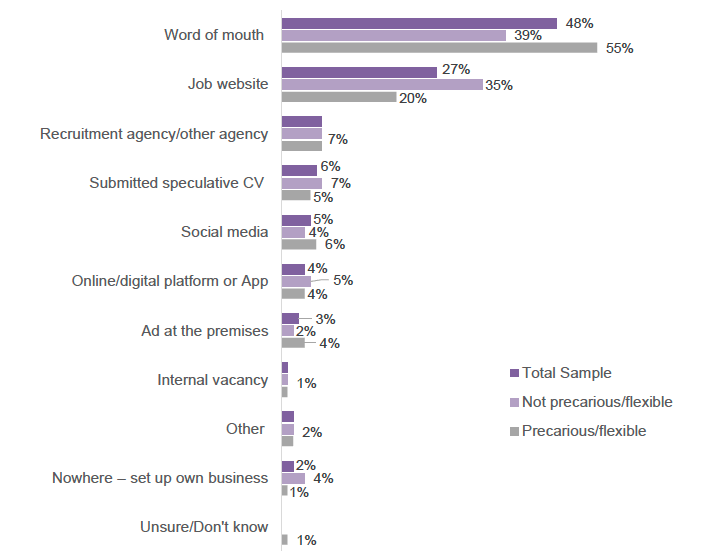
Base (all): 1043,
Precarious/flexible 569
Not precarious/flexible 473
Qualitative respondents, who were all in precarious working positions, found out about their jobs through a number of different sources ranging from job websites, word of mouth and social media. Those at the younger end of the age range were more likely to have found out about their job via word of mouth, with quite a few of them relying on their parent's friends and networks. This was particularly the case for those in more rural locations such as Galashiels and Peterhead. This further supports the fact that many of the younger sample (16-19 year olds) were not financially independent and may have been influenced by their parents to find a job in the first place.
"In Edinburgh if you're wanting a job, you have to get on with it yourself, and talk to random people. But down here [Galashiels] my mum will tag me in a job in a wee café that she goes into. It's people you know, you're comfortable with them" (Galashiels focus group participant)
"Living in the Borders, if there's a job going, someone talks about it and you'll hear about it." (Galashiels focus group participant)
7.2 Change working circumstances
Figure 7.2 shows that 49% of those in precarious or flexible work definitely (30%) or possibly (19%) wanted to change their working situation in the next 12 months. This was compared to only 24% of those not in precarious or flexible work.
Q16a. Do you want to change your working situation in the next 12 months?
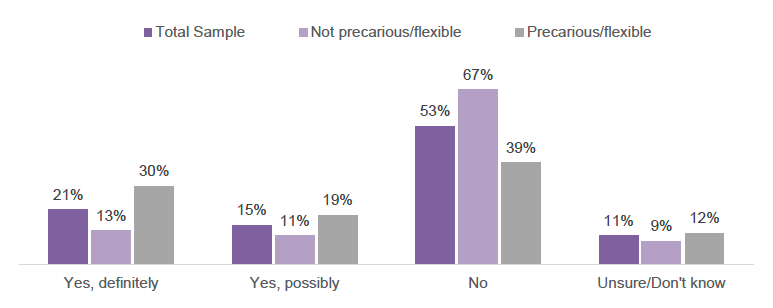
Base (all who are currently working): 879
Precarious/flexible 428
Not precarious/flexible 450
Among the precarious or flexible workers there were differences between those who wanted to change their work circumstances and those who didn't. The following exist across all those in precarious or flexible work but they are more prevalent amongst those wanting to change their working situation. They were more likely to:
- Be in temporary (27%) or casual work (29%)
- Be on a zero hours contract (34%)
- Not get guaranteed minimum hours (53%)
- Not have any of the employment rights stated such as guaranteed number of working days, holiday pay, sick pay etc.
- State that their employment impacts negatively on their mental health (25%), physical health (17%) and social life (36%).
In addition, those who wanted to change job, who were in a precarious or flexible position, were more likely to have an issue with low pay (24%), a lack of benefits (25%), given too few hours (17%) or irregular hours (18%) and lack of notice given when providing shifts (12%) than those who didn't want to change jobs.
The majority of the total sample who wanted to change their working situation wanted to change the company they worked for rather than just their position within their current company (Figure 7.3). This was the case for both audiences. Those in precarious work were significantly less likely to state that they wanted to change their position within their current company (16%) compared to those not in precarious work (28%).
Q16b. How you would like to change your working situation?

Base (all who want to change working situation): 317
Precarious/flexible 208
Not precarious/flexible 108
For those in precarious or flexible work who wanted to change their working situation, they tended to want better pay, better prospects or an increase in hours (Figure 7.4). In support of this, a number of reports reviewed in the evidence review make reference to people living day-to-day within financial constraints, including a report for the Joseph Rowntree Foundation which concluded that while pay was not the be-all and end-all, for most low-paid workers it was the element of their jobs they liked the least, and the one they would most like to change to feel happier at work (JRF, 2015).
There was a significantly higher proportion of those in precarious work who stated they wanted to increase their hours (42%) compared to those not in precarious work (17%). Almost a quarter (22%) of this audience also stated they wanted to change their contract type which was significantly higher than those not in precarious / flexible work.
Q16c. In what way would you like to change your working situation?
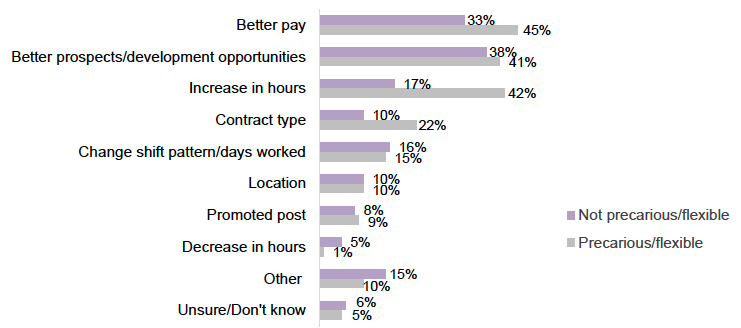
Base (all who want to change working situation):
Precarious/flexible 208
Not precarious/flexible 108
7.3 Barriers to changing working circumstances
The barriers to changing their working situation included the lack of jobs in general, lack of experience or qualifications or they just have not got round to doing it. These were similar across both sub-groups as shown in Figure 7.5.
Q17. What, if anything, might stop you from changing your working situation?
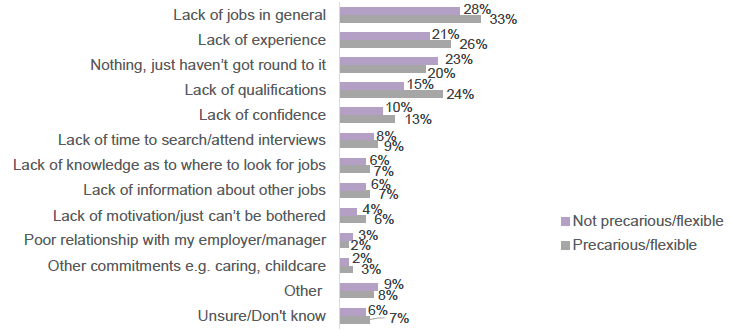
Base (all who want to change working situation):
Precarious/flexible 208
Not precarious/flexible 108
Amongst those who were in precarious or flexible work, those not in education were more likely to give lack of jobs (40%), lack of qualifications (33%) and lack of confidence (19%) as barriers to changing their working situation compared to those in full time education (25%, 13%, 6% respectively). Other differences between those in education and not in education are reported throughout this chapter. This suggests that those in these positions, not in education, who want to change their circumstances is a key group in need of support. Further analysis has been carried out on this sub group in section 7.5.
This was further supported by the qualitative findings where the barriers to changing jobs were the lack of availability of jobs, the fear that other jobs they can apply for will just be of a similar nature, as well as the lack of experience.
"Yeah, it always seems to me that once you're at the level of job that's more casual, it's all zero-hours. If you want to progress anywhere in that, you can't, you're blocked into zero-hours and that's all you're ever going to get." (Edinburgh focus group participant)
"If I wanted to go to like Tesco, all I've got is the customer experience. Like, I've not got restocking shelves or anything like that. And then everywhere wants you to have experience, but no one wants to give you the job experience." (Glasgow focus group participant).
7.4 Information, advice and guidance
Table 7.1 shows the information, help and guidance that would help those wanting to change their working situation. The top three mentions by both audiences were work experience or placement opportunities, advice on CV writing and guidance on the best place or websites to seek jobs. There were no significant differences reported across the two sub-groups.
Q18. If wanting to change your working situation in the future, what information, advice or guidance would help you to do so?
| Total Sample | Not precarious/ flexible | Precarious/ flexible | |
|---|---|---|---|
| Work experience/placement opportunities | 25% | 21% | 27% |
| Advice/guidance on CV writing | 23% | 24% | 23% |
| Guidance on where to seek jobs/best websites to use | 21% | 26% | 19% |
| Advice on current local job opportunities | 16% | 11% | 19% |
| Advice/guidance on changing career | 16% | 17% | 15% |
| Unsure/Don't know | 14% | 15% | 14% |
| Apprenticeship opportunities | 13% | 14% | 12% |
| Advice/guidance on preparing for and attending interviews | 11% | 11% | 11% |
| Access to/better entry routes to specific jobs/industries | 9% | 10% | 9% |
| Information on basic employment rights | 7% | 6% | 8% |
| Support to engage/communicate with employer | 5% | 2% | 6% |
| Awareness of/access to support groups | 3% | 4% | 2% |
| Awareness of/access to online communities | 2% | 2% | 2% |
| Other | 6% | 5% | 7% |
| Nothing | 12% | 14% | 12% |
| Base: all who want to change working situation | 317 | 108 | 208 |
Those who were not in education who were in precarious or flexible work were more likely to want work experience or placement opportunities (34%) compared to those in education who were in precarious or flexible work (20%).
The majority of those wanting to change their working situation would prefer to receive the information, advice and guidance online with 66% of those not in precarious / flexible work and 54% in precarious / flexible work stating this. This was followed by around a third stating both social media and face-to-face meetings (Figure 7.6).
Q19. How would you prefer to receive this information, advice and guidance?
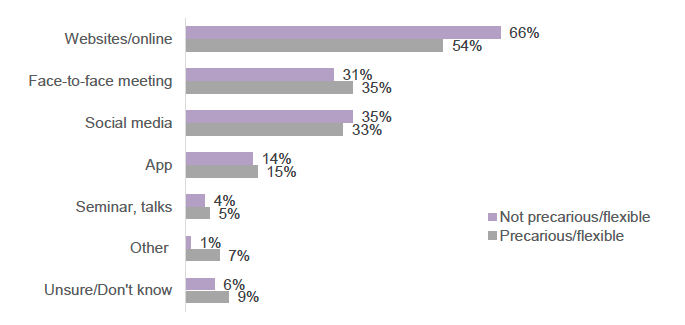
Base (all who want to change working situation excl. those who did not want information):
Precarious/flexible 184
Not precarious/flexible 93
The older group in precarious or flexible work were more likely to want information and advice online (61%) compared to the younger group (40%).
The qualitative findings reported that schools could be used more as a source of information for finding work. They were praised for helping with subject choices and applying for university and college but very little advice was given about finding part-time work to support university life, job seeking in general, understanding contracts or employment rights. All things that the respondents stated would be useful. Respondents were also interested in finding out more about CV writing, answering questions in an interview and what questions are acceptable to ask at an interview. The following quote illustrates the frustrations and a lack of support from schools that a few of the young people faced when applying for college or job seeking.
"I left school in fifth year and went to college. I was told before I leave school to speak to them [the school] about getting your application into college but also about a part time job. They were useless. My brother's had the same experience, he left school at sixteen, went through them [the school] to try and get an apprenticeship, nothing. It feels like, from his experience as well, you need to go and do it yourself because going through the school, he never got any support at all." (Edinburgh focus group participant)
7.5 People in precarious or flexible employment but not in education
Further analysis was undertaken on the sub-group of young people in precarious or flexible employment who were hoping to change their working position, to determine whether there were differences in their circumstances, views or experiences. In particular, this section focuses on whether there are differences between those who were not in education and those who were in education. The support requirements of young people who wished to change jobs was of particular interest: the types of support required and the channels for delivery.
The flow chart below quantifies the target sample for this section of the report. It shows that 428 of the precarious or flexible respondents are currently in work and, of these, around half are not looking to change their job. The 208 who would like to move to a new position are split almost equally between people who are in education and those who are not.
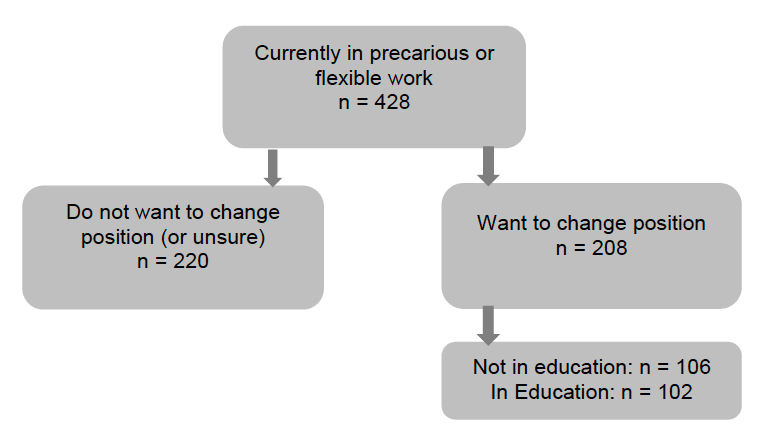
The following results show the differences of those in precarious or flexible positions who want to change their working circumstances and are not in education with those who want to change but are in education.
Profile: The profile of those in precarious or flexible work and looking to change position differs by their education status. A full breakdown of the profile of those not in education wanting to change their working situation and those in education wanting to change their working situation is shown at Appendix F. It shows that those not in education looking to change position are typically older, disproportionately from lower social groups, from disadvantaged areas, and are more likely to have responsibility for a dependent. They are more likely to come from lower social groups, indeed they are especially likely to come from social group D (accounting for 42% of those not in education compared with 19% of those in education).
Number of hours worked each week: As might be expected, those in education tend to work fewer hours per week than those not in education: around half (51%) of those in education work fewer than 15 hours per week compared with just 15% of those not in education; whereas around two-thirds (65%) of those not in education work between 15 and 40 hours per week compared with 37% of those in education.
Reasons for working: Section 3.1 above identified 'financial security' and to 'top-up income' as the main reasons attracting people to work in precarious or flexible positions (mentioned by 25% and 24% of respondents respectively). For those not in education and looking to change jobs, a somewhat different profile is evident, with the main reasons for choosing their current job given as: 'struggling to find a job' (39%), 'location' (26%) and 'financial security' (24%).
Type of contract: Those wanting to move to a new job – both those in and not in education - were more likely to be on a zero hours contract than those who did not want to change jobs (58% vs 40%), and much less likely to be on full time contract (8% vs 22%).
Satisfaction with employment: Section 6.2 above shows that overall half (50%) of the respondents in a precarious or flexible position rated their overall satisfaction with their employment at an 8, 9 or 10 out of 10. There is a marked difference in the overall satisfaction when we focus on the views of respondents currently in work. Three-quarters (75%) of those who do not want to change job rated their overall satisfaction with their current employment at an 8, 9 or 10 out of 10; this compares with two-fifths (39%) of those in education who do want to change job, and just a quarter (26%) of those not in education.
Changing job: The main reasons given by those in precarious or flexible work for wanting to change job were to get to better pay (45%), to increase hours (42%), and to improve their prospects (41%). There were some differences by education status, with those not in education more likely to want to improve their prospects (48% vs 33% of students) and to want to change their shift patterns (23% vs 7% of students).
The main barriers to changing jobs were a lack of jobs in general, a lack of qualifications and a lack of experience. Those not in education were more likely to cite a lack of jobs (40%), lack of qualifications (33%), a lack of confidence (19%) and lack of knowledge of where to look for a job (11%). They were less likely to cite 'nothing' (13%) as shown in Figure 7.8.
Q17. What, if anything, might stop you from changing your working situation?
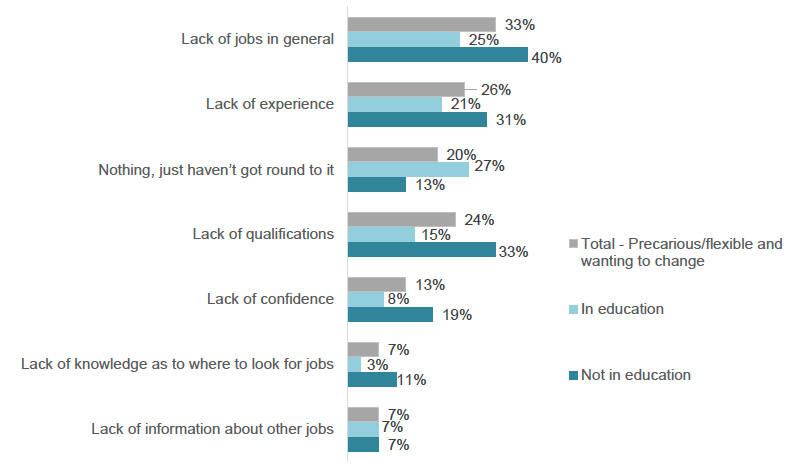
Base (Precarious, in employment and wanting to change), Total: 208
In Education: 102
Not in education: 106
Sourcing employment: The most common way respondents in this sub-group sourced jobs was through word of mouth (used by 54%). Those not in education were less likely than students to use word of mouth (42% vs 61%); and more likely to use job websites (30% vs 18%) and recruitment agencies (15% vs 1%).
Job search: The main types of support that this sub-group of respondents would find useful in changing their working situation were work experience or placement opportunities, advice on CV writing, guidance on the best place or websites to seek jobs, and advice on local job opportunities.
Those not in education were particularly likely to say they would find work experience or placement opportunities (34% mentioned this, compared with just 20% of students) and advice/guidance on changing career helpful (22% mentioned this compared with just 9% of students).
The preferred method of receiving advice and support was online (54%), with no difference between those in and not in education (Table 7.2). Just over a third (35%) indicated a preference for face-to-face; notably this rises to 44% for those not in education (compared to 26% of students). A further third indicated social media (with no differences between those in and not in education).
Q18. If wanting to change your working situation in the future, what information, advice or guidance would help you to do so?
| Total - Precarious | Not in education | In education | |
|---|---|---|---|
| Work experience/placement opportunities | 27% | 34% | 20% |
| Advice/guidance on CV writing | 23% | 25% | 21% |
| Guidance on where to seek jobs/best websites to use | 19% | 21% | 17% |
| Advice on current local job opportunities | 19% | 19% | 20% |
| Advice/guidance on changing career | 15% | 22% | 9% |
| Apprenticeship opportunities | 12% | 13% | 11% |
| Advice/guidance on preparing for and attending interviews | 11% | 12% | 9% |
| Access to/better entry routes to specific jobs/industries | 9% | 9% | 9% |
| Information on basic employment rights | 8% | 7% | 9% |
| Support to engage/communicate with employer | 6% | 2% | 11% |
| Awareness of/access to support groups | 2% | 3% | 1% |
| Awareness of/access to online communities | 2% | 3% | 2% |
| Other | 7% | 5% | 9% |
| Nothing | 12% | 12% | 11% |
| Unsure/Don't know | 14% | 15% | 13% |
| Base: all who want to change working situation | 208 | 106 | 102 |
Contact
Email: youngpersonguar@gov.scot
There is a problem
Thanks for your feedback